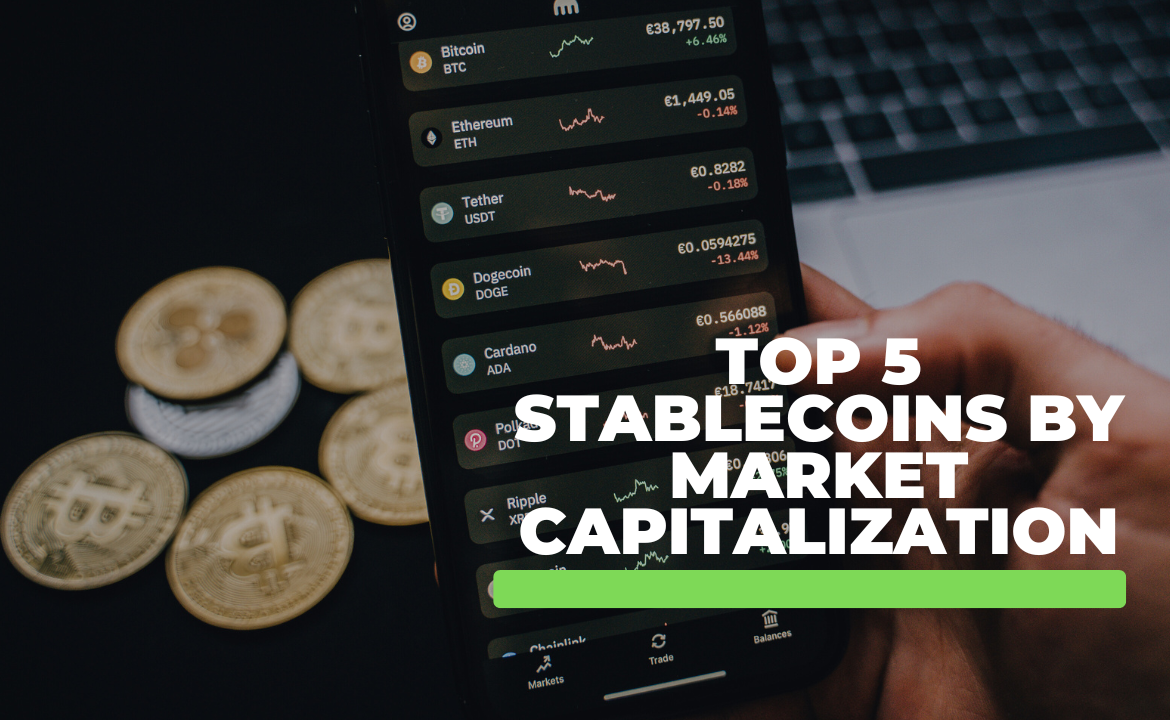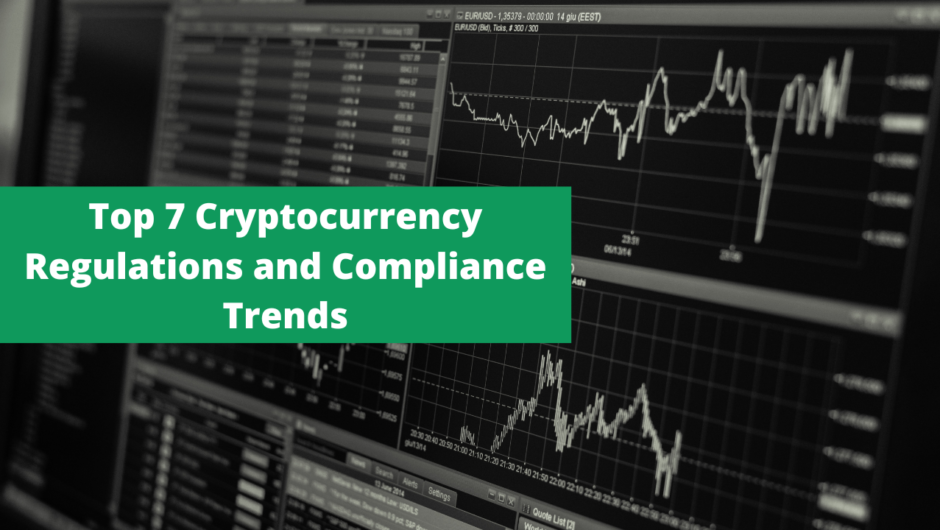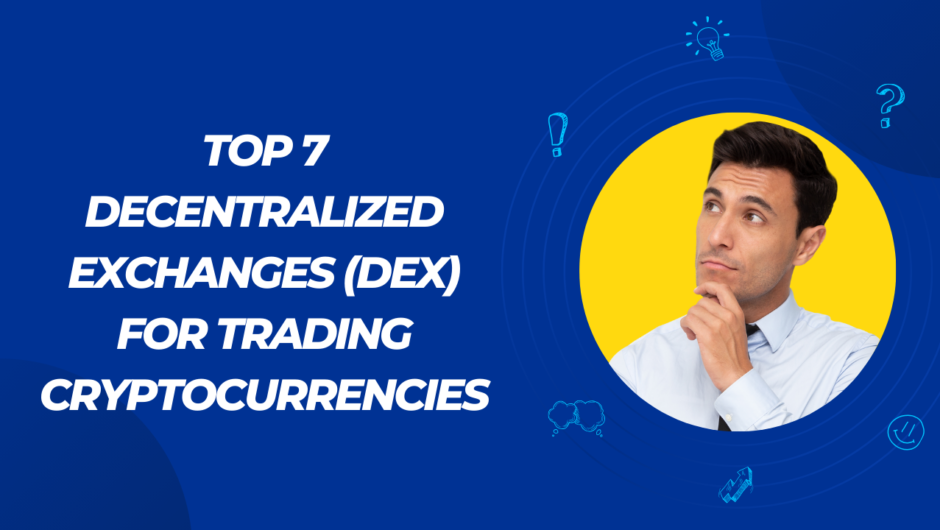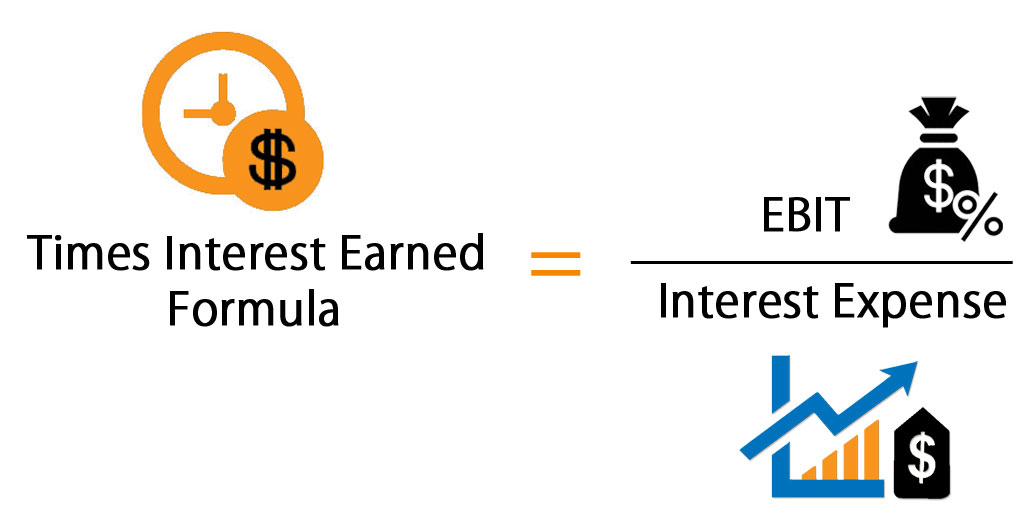Stablecoins in the cryptocurrency ecosystem, offering stability amidst the volatile nature of digital assets. These digital currencies are pegged to traditional fiat currencies or assets, ensuring a consistent value and facilitating seamless transactions within the crypto space. With their market capitalization reflecting the total value of stablecoins in circulation, they serve as a cornerstone for various financial activities such as trading, remittances, and decentralized finance (DeFi) applications. As stablecoins continue to gain traction and innovation in the crypto market, understanding their market capitalization provides insights into the overall health and maturity of the digital asset landscape.
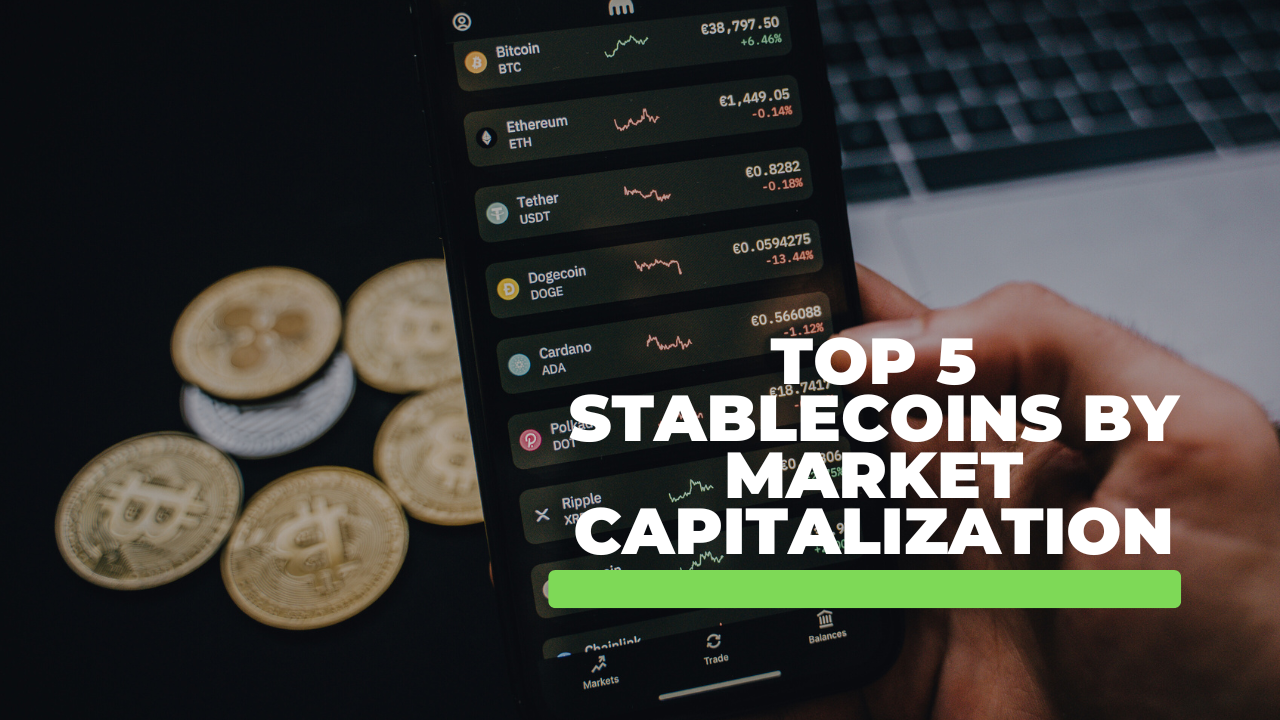
The top 5 stablecoins by market capitalization are:
1. Tether (USDT)
Tether, known by its symbol USDT, stands as a pioneering force in the realm of stablecoins. Revolutionizing the digital token space since its inception in 2014. As the world’s first stablecoin. Tether tokens are backed 1-to-1 by fiat currencies, providing stability and reliability in an otherwise volatile cryptocurrency market. With a market capitalization reflecting its widespread adoption, Tether has emerged as the most widely used stablecoin. It is facilitating billions in transactions across major exchanges, OTC desks, and wallets worldwide.
What sets Tether apart is its commitment to transparency and security. Tether ensures that all USDT tokens are fully backed by reserves and publishes daily records of its assets. Offering users peace of mind and confidence in its stability. Moreover, Tether tokens operate across multiple blockchains, enhancing accessibility and interoperability for users across the globe. The impact of Tether extends beyond its role as a digital currency. Through collaborations and initiatives, such as the recent partnership with Coins.ph in the Philippines. Tether is driving financial education and inclusion, empowering individuals and businesses to navigate the digital asset economy effectively.
Tether’s support for open-source software development, as evidenced by the $100,000 grant awarded to the BTCPay Server Foundation, underscores its commitment to advancing the broader cryptocurrency ecosystem.
2.USDC
USDC, or USD Coin, in the digital currency landscape, offering fully backed digital dollars that are redeemable 1:1 for US dollars. With a market capitalization of $32.1 billion in circulation and $32.2 billion in reserves as of April 11, 2024. USDC provides a stable and regulated means for global payments and financial transactions. USDC apart is its speed, stability, and near-zero cost, making it an attractive choice for businesses seeking efficient cross-border payments. And also, individuals looking for accessible digital currency solutions. Moreover, USDC’s transparency and regulatory compliance provide users with confidence in its stability and reliability. As reserves are held at regulated financial institutions and undergo monthly attestations.
USDC’s global reach is evidenced by its widespread adoption across popular exchanges, protocols, and thousands of developers building with USDC. Partnerships with companies like Visa, BlackRock, and MoneyGram further solidify. USDC’s position as a trusted digital currency for facilitating a wide range of financial services, from cross-border payments to marketplace payouts.
USDC empowers businesses and individuals alike to participate in the growing digital asset economy and access the benefits of blockchain technology.
3. Binance USD (BUSD)
Binance USD (BUSD) is a stablecoin pegged 1:1 to the US dollar and approved by the New York State Department of Financial Services (NYDFS). It is providing users with a secure and transparent digital asset backed by fiat currency. Launched on May 21st, 2020, BUSD is issued by Paxos in collaboration with Binance. Ensuring regulatory compliance and reliability in the digital currency ecosystem.
With 187,325,484 users, Binance is a trusted platform for cryptocurrency trading and investment. BUSD operates on the Ethereum blockchain, offering users seamless access to decentralized finance (DeFi) platforms. Like Curve Finance and Uniswap, where BUSD is tradable alongside other digital assets. Binance offers a wrapped version of BUSD (Binance-Peg) on the Binance Smart Chain (BEP-20). Expanding BUSD’s utility and interoperability within the Binance ecosystem. However, it’s important to note that Binance-Peg BUSD is a product of Binance and is not issued or regulated by Paxos or the NYDFS.
BUSD’s transparent reserves and regulatory approval instill confidence among users. Making it a preferred stablecoin for various use cases, including trading, remittances, and payments.
4. Dai (DAI)
Dai (DAI) in the world of stablecoins as a decentralized cryptocurrency designed to maintain a value of $1.00 USD through a unique mechanism. Operating on the Ethereum blockchain, Dai is not backed by US dollars held in a bank account like centralized stablecoins. Instead, it relies on collateral locked up in the Maker platform to secure its value.
One of the key features of Dai is its decentralization. Unlike traditional stablecoins, Dai is not issued or controlled by a single entity. Instead, its creation and management are governed by the Maker Protocol and the MakerDAO decentralized autonomous organization (DAO). This democratic governance model involves the holders of Maker (MKR) governance tokens. Those who collectively make decisions regarding the protocol’s operation and parameters. Dai serves as a reliable medium of exchange and store of value, ideal for use in decentralized finance (DeFi) applications and smart contracts. Its stability relative to the US dollar makes it particularly valuable for users seeking to avoid the volatility inherent in many other cryptocurrencies.
However, it’s important to note that Dai’s value stability relies on the collateral backing it on the Maker platform.
5. TerraUSD (UST)
TerraUSD (UST) represents a significant advancement in the realm of decentralized stablecoins. Providing users with a scalable and yield-bearing coin that maintains a value pegged to the US Dollar. Developed as part of the Terra blockchain ecosystem, UST offers several key advantages over other stablecoin competitors, particularly in terms of scalability, interest rate accuracy, and interchain compatibility.
Features of TerraUSD is its minting mechanism, which enables it to meet the demands of decentralized finance (DeFi) protocols without sacrificing scalability. This ensures that UST can be seamlessly integrated into various DeFi applications, providing users with access to a stable and reliable asset for their financial activities. TerraUSD’s versatility extends beyond DeFi, as it can be easily integrated into cryptocurrency wallets as a payment method. This accessibility enhances its utility and adoption among users, further solidifying its position as a leading stablecoin in the market. TerraUSD plays a crucial role in decentralized applications (DApps) that rely on stable pricing benchmarks.
Since its launch in September 2020 in collaboration with Bittrex Global, TerraUSD has garnered a reputation as one of the most scalable stablecoins available.
Conclusion
Stablecoins, with their stable value proposition and widespread adoption, have emerged as foundational assets in the cryptocurrency space. Tether (USDT), USD Coin (USDC), Dai (DAI), TerraUSD (UST), and others dominate the stablecoin market by market capitalization. These digital currencies offer stability, liquidity, and accessibility, making them instrumental in various use cases, including decentralized finance (DeFi), remittances, and cross-border payments. As the crypto market continues to mature, stablecoins are poised to play an increasingly vital role, providing stability and reliability amidst the volatility of other cryptocurrencies, and serving as a bridge between traditional finance and the burgeoning digital economy.
Also Read:
- What is Dividend Investing and How to find Dividend Stocks?
- How do new mobile banking apps help access savings account better?
- Financial Advisor in India – The Best for your Financial Planning?
- What is inflation and how it impacts your financial plan?

Hello, I am Tanisha Kriplani, graduated in computer science from Delhi University. I am passionate about web content writing and have a strong interest in Data Analytics and Data Engineering.

